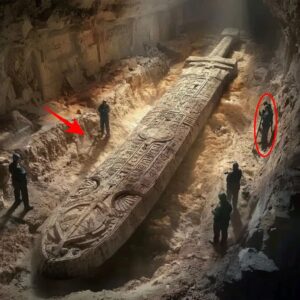An extremely rare golden seal dating back to the 1600s that belonged to a Chinese emperor-to-be has been unveiled by archaeologists studying the remnants of a Ming dynasty battlefield.
Amazing images showed the discovery of the ancient power symbol, which weigh over 17 pounds and is 95 per cent pure gold, marks the first time researchers have found an item of gold treasure belonging to the prince and heir apparent of a Chinese imperial throne.
Lead archaeologist Liu Zhiyan, director of archaeometry at the Sichuan Provincial Cultural Relics and Archaeology Research Institute, called it ‘among the most significant finds in recent years’ and ‘the only one of its kind in the world’.

Amazing images show a centuries-old royal family golden seal weighing over 17 pounds unearthed by Chinese archaeologists studying the remnants of a Ming dynasty battlefield

With the latest discovery, 500 million yuan (£56.3 million) has been invested in the construction of a Jiangkou Chenyin museum, which will begin at the end of 2020. Pictured, Jiangkou Chenyin Historic Site on the banks of the Min River

The discovery of the ancient power symbol, which is 95 percent pure gold, marks the first time researchers have found an item of gold treasure belonging to the prince and heir apparent of a Chinese imperial throne
Huge archeological dig seen in southwest China
The intricately carved stamp, which measures 10 by 10 centimetres (4 by 4 inches) and has a pure-gold handle in the shape of a tortoise, bears the words ‘Shu Shi Zi Bao’, meaning ‘Treasure of the Shu Prince’.
It is believed that the treasure was deliberately shattered when the monarchy was overthrown during a violent and bloody peasant uprising more than 370 years ago.
The golden seal, along with around 10,000 other artefacts, were unveiled on Tuesday as Mr Liu’s team concluded months of excavations at the Jiangkou Chenyin Historic Site beginning on 10th January this year.
It was the third phase of a larger archaeological project which started in the spring of 2017 on the banks of the river Min in the Sichuan town of Jiangkou.
Britain’s loneliest sheep stranded for two years is finally rescued
1.2k viewing now
At the start of the low season in November 2019, teams of workers began surrounding the 5,000-square-metre (54,000-square-foot) dig site with an embankment before water was drained away to reveal the riverbed.
Among the finds, more than 2,000 of which were of ‘significant value’, were gold, silver and bronze coins, ingots, cutlery, adornments and jewellery.
But the golden seal, which was found shattered in four pieces, remains the most noteworthy.

Among the finds, more than 2,000 of which were of ‘significant value’, were gold, silver and bronze coins, ingots, cutlery, adornments and jewellery. A gold ingot unearthed at the Jiangkou Chenyin dig site in Sichuan of south-western China

It is thought to have been in the possession of Zhang Xianzhong – also romanised as Chang Hsien-chung – who led the peasant revolt which conquered modern-day Sichuan and its largest city of Chengdu in 1644 during the fall of the Ming dynasty
It is thought to have been in the possession of Zhang Xianzhong – also romanised as Chang Hsien-chung – who led the peasant revolt which conquered modern-day Sichuan and its largest city of Chengdu in 1644 during the fall of the Ming dynasty.
‘The most plausible theory is that he had the seal split into four pieces to symbolise the end of the Ming dynasty,’ Mr Liu noted.
Historical texts claim that when Zhang himself fled Chengdu in 1646 to escape the invading Manchus – founders of China’s last empire Qing (1644 to 1912) – he was ambushed by Ming loyalist general Yang Zhan, losing around 1,000 ships as well as the treasures they contained to the depths of the Min River.

‘The most plausible theory is that he had the seal split into four pieces to symbolise the end of the Ming dynasty,’ Mr Liu noted. A gold coin unearthed at the Jiangkou Chenyin dig site in Sichuan province of south-western China

Zhang, who was known as the ‘Yellow Tiger’, was slain by the Manchus in January of the following year. A silver ingot unearthed at the Jiangkou Chenyin dig site
Zhang, who was known as the ‘Yellow Tiger’, was slain by the Manchus in January of the following year.
Mr Liu said: ‘During phase three of the dig, we made two very important observations.
‘The first is that the artefacts were found deep in the rock and riverbed, meaning they had been there for a long period of time.
‘This tells us that this section of the river is very likely the battlefield where Zhang Xianzhong and Yang Zhan crossed swords.

The golden seal, along with around 10,000 other artefacts, were unveiled on Tuesday as Mr Liu’s team concluded months of excavations at the Jiangkou Chenyin Historic Site beginning on 10th January this year
‘Secondly, we can see from the grouping of the artefacts how Zhang had categorised and organised his treasures when he left Chengdu.
‘During the first and second excavations, we found mostly weapons, utensils and adornments, but the third dig revealed treasures such as coins and other valuables.’
Mr Liu said further historical research would be done to determine precisely which Shu prince the seal had belonged to.
According to reports, Zhang’s treasures began washing ashore in the town of Jiangkou between the 1950s and 1990s.
The first formal excavation began in April 2017, and the second in January 2018. More than 52,000 artefacts have been unearthed to date.
With the latest discovery, 500 million yuan (£56.3 million) has been invested in the construction of a Jiangkou Chenyin museum, which will begin at the end of 2020.

The first formal excavation began in April 2017, and the second in January 2018. More than 52,000 artefacts have been unearthed to date. Pictured, archaeologists working at the dig site

The first formal excavation began in April 2017, and the second in January 2018. More than 52,000 artefacts have been unearthed to date. The picture shows the Jiangkou Chenyin Historic Site on the banks of the Min River




